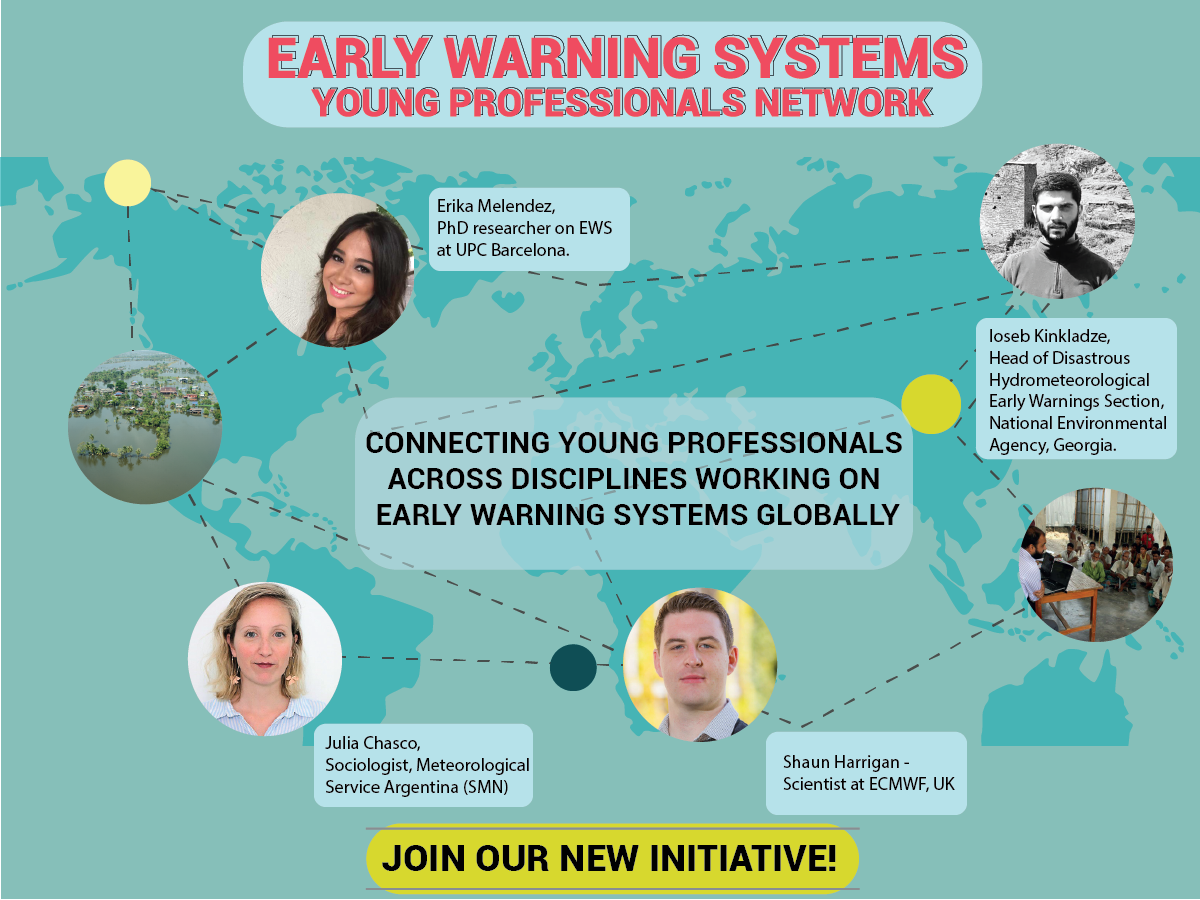Integration of Early Warning Systems and Young Professionals
Contributed by Nilay Dogulu, Lydia Cumiskey and Erika Roxana Meléndez Landaverde
Early warning systems (EWSs) help society to prepare for, and respond to, all types of disasters, including those related to hydrometeorological hazards. The recent floods in Mozambique has clearly showed that EWSs are inevitable part of disaster risk management as they can save lives and minimize potential economic and environmental damages. The Sendai Framework for Disaster Risk Reduction 2015–2030 specifically emphasizes the need to “substantially increase the availability of and access to multi-hazard early warning systems and disaster-risk information and assessments to the people by 2030.”
The fundamentally central aspect to efficient and sustainable improvements for EWS concerns integration. As highlighted by the World Meteorological Organization’s (WMO) recent Governance Reform, a shift towards more integrated earth systems approach connecting fields such as hydrology, meteorology and climatology is key to delivering multi-hazard and impact-based services through EWSs that are people-centred (i.e. community based).
What role can young professionals play?
While the complexities and challenges are many, young professionals can play a role in the design and implementation of integrated multi-hazard and impact-based EWSs.
The Disaster Risk Reduction (DRR) team of the Water Youth Network has recently initiated a network called Early Warning Systems Young Professionals Network with the purpose of connecting young professionals working on EWSs from various disciplines of science, policy and practice in the public, private and non-profit sectors. It is currently focused on water-related hazards. Members are under the age of 35 or within their first seven years of employment. The specific aims of the network are:
- Understand challenges and needs
- Share knowledge
- Build interdisciplinary working relationships
Why not join the Early Warning Systems Young Professionals Network? Click HERE! (Source: Water Youth Network)
Interviewing EWS young professionals
As part of the initiative, we interviewed 17 young professionals working in the field of EWSs back in December 2018. The interviewees are from different parts of the world and working in hydro-met agencies, disaster management authorities, NGOs, research institutes and private sector. Overall, the interviews point out the current opportunities and challenges to support integrated approaches to EWSs.
With our recently published article in the WMO Bulletin, we wanted to examine, based on the evidence collected by the interviews, why young professionals – who would be mid-career by 2030 – are in a prime position to support integration efforts and highlight the mechanisms that would enable them to achieve greater impact.
It was not surprising to see that everyone participated in interviews agreed that young professionals bring energy and enthusiasm as well as openness and flexibility to try new things and adopt innovation, especially in communications. These characteristics can help promote integration of the EWSs value chain and ensure an interdisciplinary approach.
The interviews revealed the below listed opportunities for young professionals to enable integration:
- Openness to new technology, learning and communication;
- Ability to span disciplinary boundaries;
- Proactive and motivated attitude.
To drive integration of EWSs, enabling mechanisms to support young professionals need to be developed. The young EWS professionals we interviewed draw attention to the following aims that such mechanisms shall consider:
- Strengthening links between research and practice;
- Developing inter-disciplinary skills and job opportunities;
- Giving more responsibility/leadership;
- Creating networks at global, national and local levels.
Interviewing 17 EWS young professionals across continents was not very difficult. It took only time and motivation (and internet connection) to conduct such a study. We believe that the magical ingredient was our high motivation – it unlocks the potential of minds and hearts once you have it in the right amount. Our voluntary efforts will prove worthwhile considering the need for increasing awareness on the matter and help the EWS community grow stronger together regardless of geographical boundaries (and time zone differences! :)).
The EWS young professional network is still under development!
We plan to continue conducting more interviews with young professionals from diverse fields and positions worldwide to inform the development of our network. We are also organizing a side event “Bridging disciplines and building networks – young professionals perspective” at the Second Multi-Hazard Early Warning Conference (MHEWC-II) to be held between 13 – 14 May 2019 in Geneva, Switzerland. The details of the event can be found here.
We hope that our article, as well as this HEPEX blog post, will help the community realize the influence young professionals could have in building interdisciplinary networks to collaborate, exchange knowledge and share opportunities at the local, regional and global levels. As those young professionals gain experience and responsibility, they will come into leadership roles. We urge readers to help us to expand our network by spreading the word and encouraging young professionals to join us.
If you are interested in reading the full article, you can access it freely through the following links:
- Cumiskey L., N. Dogulu, E. Landaverde, J. Ali, and F. Sai. (2019). The Role of Young Professionals in Driving the Integration of Early Warning Systems, World Meteorological Organization Bulletin, 68(1), 38- 44. (Full PDF)
- WMO for the 21st Century, Bulletin Vol.68(1) 2019, WMM
Acknowledgements from the authors: We would like to thank all the young professionals who took part in the interviews and the WYN members who are supporting the development of the Network. Special thanks to WMO for the opportunity and the reviewers who helped improve the article greatly.
This is a cross-post with the YHS Blog.

0 comments